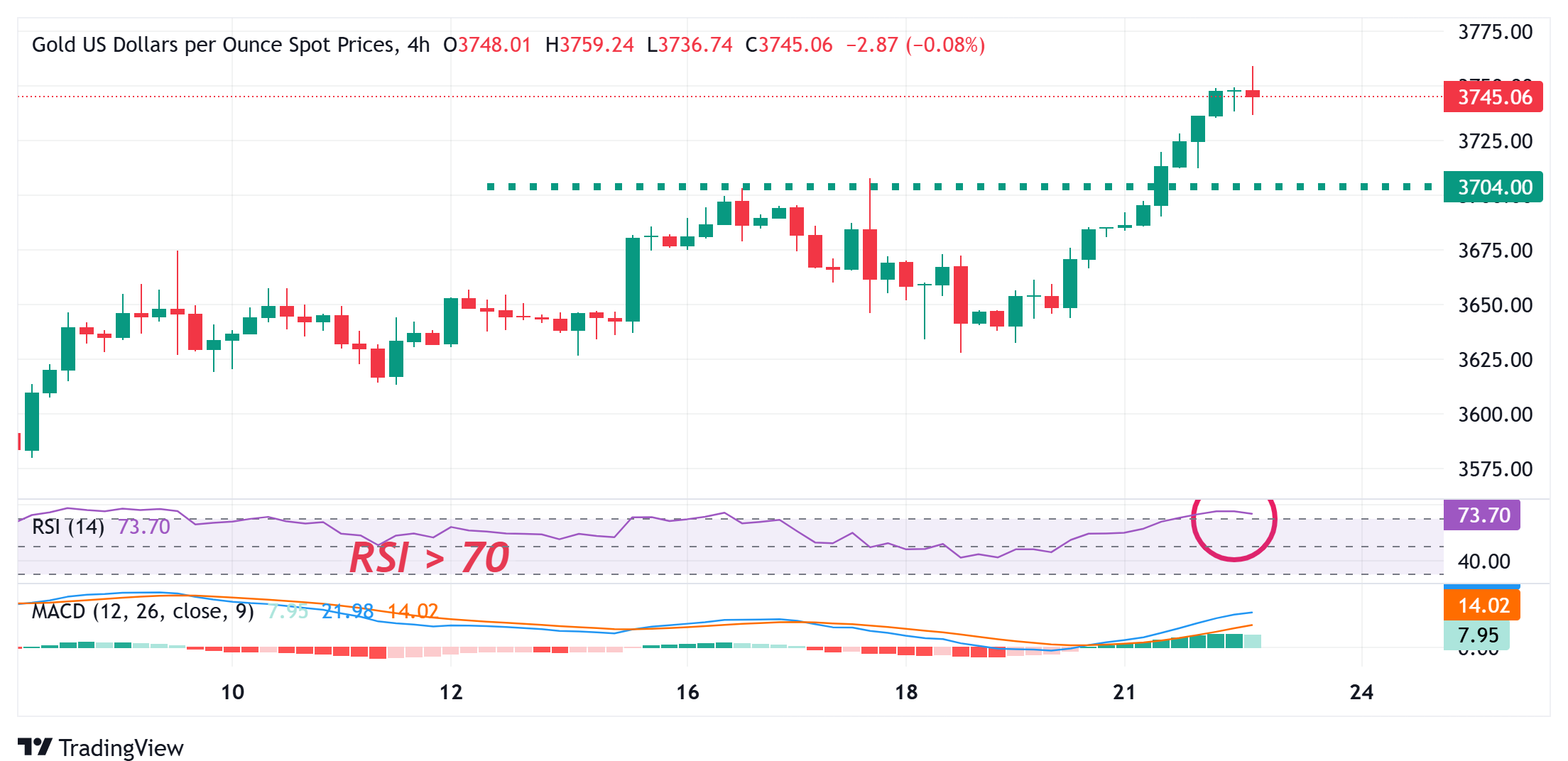Created
: 2025.09.23














![]() 2025.09.23 13:08
2025.09.23 13:08
Gold (XAU/USD) retreats slightly after touching a fresh all-time peak, in the $3,759-3,760 zone during the Asian session on Tuesday, as bulls turn cautious amid extremely overbought conditions. Furthermore, a generally positive tone around the equity markets turns out to be another factor acting as a headwind for the safe-haven commodity. However, any meaningful corrective decline still seems elusive in the wake of dovish Federal Reserve (Fed) expectations, which might continue to offer support to the non-yielding yellow metal.
In fact, the US central bank lowered borrowing costs last Wednesday for the first time since December and signaled that two rate cuts would follow through this year amid signs of a softening labor market. This, in turn, keeps the US Dollar (USD) depressed below a one-week high, touched on Monday, and should offer some support to the Gold. Moreover, geopolitical risks stemming from the Russia-Ukraine war and conflicts in the Middle East should limit losses for the commodity ahead of Fed Chair Jerome Powell's speech later today.

From a technical perspective, the overnight breakout and close above the $3,700 mark could be seen as a fresh trigger for bullish traders. Moreover, the recent move up remains unaffected by the overbought Relative Strength Index (RSI) on the daily chart. This, in turn, backs the case for a further near-term appreciating move for the Gold price, suggesting that any corrective slide could be seen as a buying opportunity.
Meanwhile, the $3,726-3,725 region now seems to protect the immediate downside ahead of the $3,700 round figure. The next relevant support is pegged near the $3,686-3,685 zone, which, if broken, might prompt some technical selling and drag the Gold price to the $3,651-3,650 area. A convincing break below the latter would point to a possible bullish exhaustion and pave the way for a deeper corrective decline.
Monetary policy in the US is shaped by the Federal Reserve (Fed). The Fed has two mandates: to achieve price stability and foster full employment. Its primary tool to achieve these goals is by adjusting interest rates. When prices are rising too quickly and inflation is above the Fed's 2% target, it raises interest rates, increasing borrowing costs throughout the economy. This results in a stronger US Dollar (USD) as it makes the US a more attractive place for international investors to park their money. When inflation falls below 2% or the Unemployment Rate is too high, the Fed may lower interest rates to encourage borrowing, which weighs on the Greenback.
The Federal Reserve (Fed) holds eight policy meetings a year, where the Federal Open Market Committee (FOMC) assesses economic conditions and makes monetary policy decisions. The FOMC is attended by twelve Fed officials - the seven members of the Board of Governors, the president of the Federal Reserve Bank of New York, and four of the remaining eleven regional Reserve Bank presidents, who serve one-year terms on a rotating basis.
In extreme situations, the Federal Reserve may resort to a policy named Quantitative Easing (QE). QE is the process by which the Fed substantially increases the flow of credit in a stuck financial system. It is a non-standard policy measure used during crises or when inflation is extremely low. It was the Fed's weapon of choice during the Great Financial Crisis in 2008. It involves the Fed printing more Dollars and using them to buy high grade bonds from financial institutions. QE usually weakens the US Dollar.
Quantitative tightening (QT) is the reverse process of QE, whereby the Federal Reserve stops buying bonds from financial institutions and does not reinvest the principal from the bonds it holds maturing, to purchase new bonds. It is usually positive for the value of the US Dollar.
![]()
Created
: 2025.09.23
![]()
Last updated
: 2025.09.23

FXStreet is a forex information website, delivering market analysis and news articles 24/7.
It features a number of articles contributed by well-known analysts, in addition to the ones by its editorial team.
Founded in 2000 by Francesc Riverola, a Spanish economist, it has grown to become a world-renowned information website.
We hope you find this article useful. Any comments or suggestions will be greatly appreciated.
We are also looking for writers with extensive experience in forex and crypto to join us.
please contact us at [email protected].
Disclaimer:
All information and content provided on this website is provided for informational purposes only and is not intended to solicit any investment. Although all efforts are made in order to ensure that the information is correct, no guarantee is provided for the accuracy of any content on this website. Any decision made shall be the responsibility of the investor and Myforex does not take any responsibility whatsoever regarding the use of any information provided herein.
The content provided on this website belongs to Myforex and, where stated, the relevant licensors. All rights are reserved by Myforex and the relevant licensors, and no content of this website, whether in full or in part, shall be copied or displayed elsewhere without the explicit written permission of the relevant copyright holder. If you wish to use any part of the content provided on this website, please ensure that you contact Myforex.
Myforex uses cookies to improve the convenience and functionality of this website. This website may include cookies not only by us but also by third parties (advertisers, log analysts, etc.) for the purpose of tracking the activities of users. Cookie policy